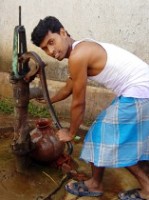In its Clean Watersheds Needs Survey, EPA summarizes data from 47 states and predicts the nation will need most of the money for wastewater treatment and collection systems over the next 20 years.

We've found a few more resources that may be helpful to you.
This week, EPonline features a hazardous air pollutants monitoring chart from Airgas, Inc., drinking water information from NSF International, and a coolant troubleshooting guide for metalworkers from Zebra Skimmers Corporation.
Working for TVA, the lab is continuing its research to determine if selenium and other contaminants will have a long-term effect on fish populations.
American Recovery and Reinvestment Act funds helped to speed DOE's project to remove about 2,300 cubic feet of radioactive waste from California.
Lead paint rule spurred RTI International to develop a method that uses a simple, portable turbidity meter that measures the amount of light blocked by suspended particles in solution.
A jury found two brothers guilty of fraud, violating the Clean Air Act, and illegally dumping asbestos in Poland, N.Y. Their father pleaded guilty before the trial.
Clinton Climate Initiative’s Magaziner, FERC Chair Wellinghoff and Secretary of Commerce Locke to speak at Virtual Energy Forum.
The Datong mine ventilation air methane abatement system will use MEGTEC's Vocsidizer technology.
The Florida-based marine lab is seeking volunteers and donations to protect Gulf of Mexico sea life.
Submission deadline is July 26 and the conference will be held April 3-5 in Philadelphia.
Cynthia Dougherty will start the agency's outreach campaign to build a new drinking strategy at the American Water Works Association conference.
Safety and Ecology Corporation will earn $2.5 million for remediating a nuclear laboratory in Argonne and demolishing a DOE complex in Oak Ridge.
Agency is in discussions with Makhteshim Agan of North America, the insecticide's manufacturer.
Employees of Cooperative Success Maritime, a ship management company, were falsifying record book logs and discharging oily bilge water into the ocean.

Deeper wells will be useful for safer drinking water, but not for irrigation water that relies on mechanized pumps that speed arsenic migration.